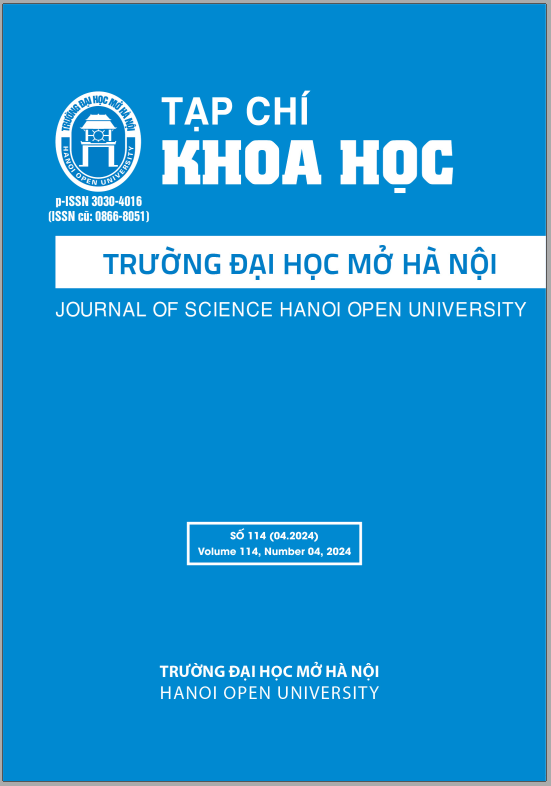KHẢO SÁT THÍ ĐIỂM NĂNG LỰC NGÔN NGỮ TIẾNG ANH CỦA SINH VIÊN KHOA DU LỊCH, TRƯỜNG ĐẠI HỌC MỞ HÀ NỘI
DOI:
https://doi.org/10.59266/houjs.2024.384Keywords:
năng lực ngôn ngữ tiếng Anh, khảo sát thí điểm, giao tiếp, bảng hỏi, phỏng vấnAbstract
Hiện nay, du lịch đóng vai trò quan trọng trong kết nối toàn cầu, vì vậy việc có năng lực ngôn ngữ tốt bằng một ngôn ngữ quốc tế, đặc biệt là tiếng Anh là vô cùng quan trọng, giúp sinh viên du lịch, nguồn nhân lực du lịch tương lai, có thể tự tin giao tiếp với khách quốc tế và nâng cao sự hài lòng của du khách. Vì vậy, nhóm nghiên cứu đã tiến hành khảo sát thí điểm lấy đánh giá của 09 giảng viên tiếng Anh và 157 sinh viên cuối năm thứ ba của Khoa Du lịch về năng lực ngôn ngữ tiếng Anh (English linguistic competences) của sinh viên nhằm tìm hiểu nhận định của các bên liên quan về năng lực ngôn ngữ tiếng Anh hiện tại của các em. Kết quả thu được tích cực nhưng cũng gợi mở sự cần thiết phải tăng cường hơn nữa các chiến lược giúp nâng cao hơn năng lực hiện tại của sinh viên, giúp củng cố thêm chuẩn đầu ra của chương trình đào tạo, đóng góp cho ngành du lịch Việt Nam nguồn nhân lực chất lượng hơn. Các phỏng vấn kèm theo đã cung cấp thêm các kết quả thú vị, làm rõ hơn các kết quả thu được từ bảng hỏi.
References
[1]. A. Priyanto. The correlation between English grammar competence and speaking fluency of eleventh grade students in SMAN. RETAIN, 2013, 1, 1, 1-6.
[2]. Council of Europe. Common European Framework of Reference for Languages: Learning, Teaching, Assessment. Cambridge University Press: 2001; ISBN 978-92-871-8621-8.
[3]. D.H. Hymes. On Communicative Competence. Penguin:1972; ISBN: 9783110188295.
[4]. E. Kellerman, T. Bongaertsand & N. Poulisse. Strategy and System in L2 Referential Communication. Printice Hall:1987.
[5]. 4. E. Oh. Comparative studies on the roles of linguistic knowledge and sentence processing speed in L2 listening and reading comprehension in an EFL tertiary setting. Reading Psychology, 2016, 37, 2, 257-285. doi: 10.1080/02702711.2015.1049389.
[6]. F. Heidari & S. A. Alavi. Knowledge of grammar, oral communication strategies, and oral fluency: A study of Iranian EFL learners. Iranian Journal of Applied Language Studies, 2015, 7, 1, 83-104.
[7]. G. Mehdi. Lexical relations and the use of communication strategies: A competence analysis study. Kufa Journal of Arts, 2008, 3, 88-122, doi: 10.36317/kaj/2010/v1.i3.6515.
[8]. Hoàng Thị Thanh. Giải pháp nâng cao năng lực giao tiếp bằng tiếng Anh cho sinh viên Khoa Du lịch, Trường Đại học Mở Hà Nội. Đề tài NC KH&CN cấp trường mã số MHN 2023-02.24; 2023.
[9]. K. Araki. Does teaching grammar really hinder students’ speaking abilities? US-China Education Review, 2015, 5, 6, 400-408, doi:10.17265/2161-623X/2015.06A.003.
[10]. L. F. Bachman. Fundamental Considerations in Language Testing. Oxford University Press: 1990.
[11]. M. Canale & M. Swain. A Theoretical Framework for Communicative Competence. Georgetown University Press: 1980
[12]. M., Celce-Murcia, Z. Dornyei & S. Thurrell. Communicative competence: A
[13]. pedagogically motivated model with content specifications. Issues in Applied Linguistics, 1995, 6, 2, 5-35.
[14]. N. Chomsky. Aspects of the Theory of Syntax. MIT Press: 1957; ISBN 0262260506, 9780262260503.
[15]. P. D. Prashant. Importance of pronunciation in English language communication. Voice of Research, 2018, 7, 2, 15-20.
[16]. S. J. Savignon. Communicative Competence: Theory and Classroom Practice. The McGraw-Hill Companies, Inc: 1972. 10.2307/330239, ISBN 10: 0070837368 - ISBN 13: 9780070837362.
[17]. S. J. Savignon. Communicative Language Teaching: Linguistic Theory and Classroom Practice. Yale University Press: 2002.
[18]. T. Segler, H. Pain & A. Sorace. Second Language Vocabulary Acquisition and Learning Strategies. University of Edinburgh Press: 2002, ISBN 1847698964, 9781847698964.
[19]. Y. F. Liao. Investigating the construct validity of the grammar and vocabulary section and the listening section of the ECCE: Lexico-grammatical ability as a predictor of L2 listening ability. Spaan Fellow, 2007, 37, 37-116.
